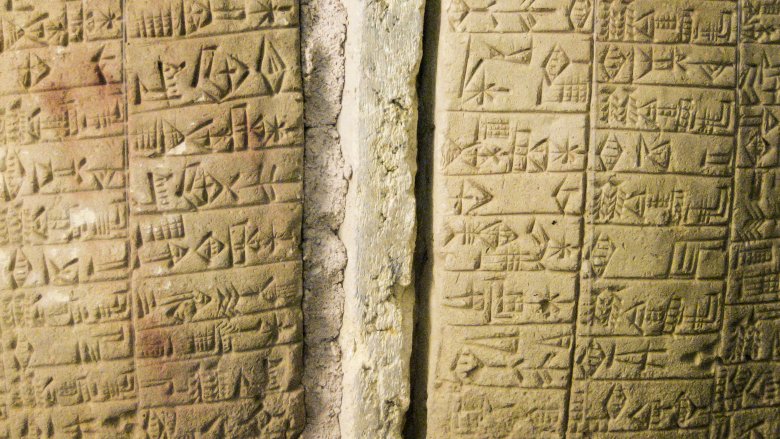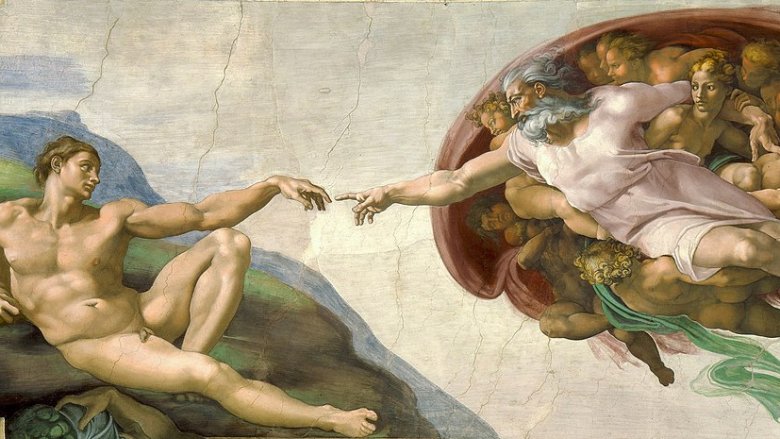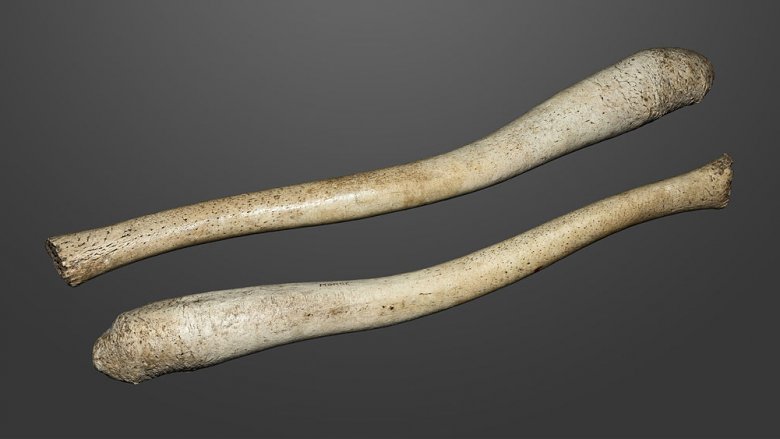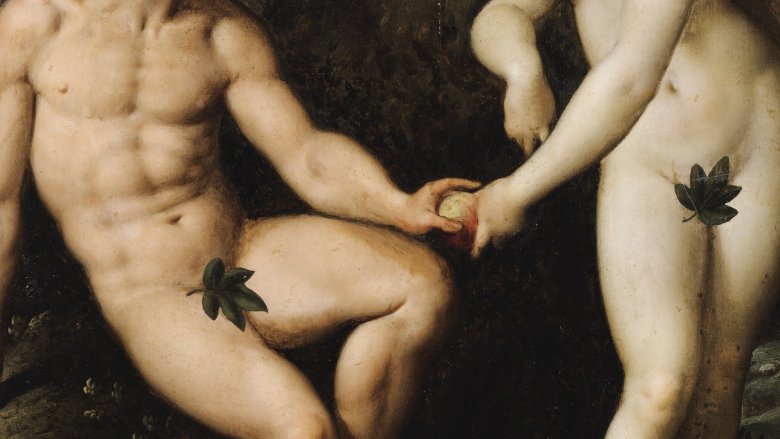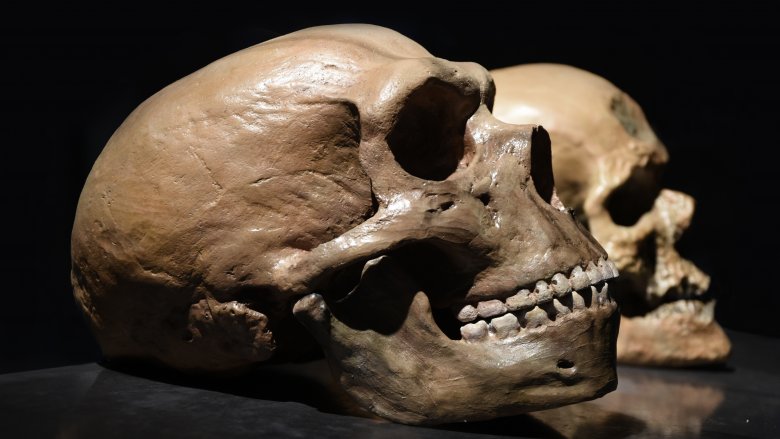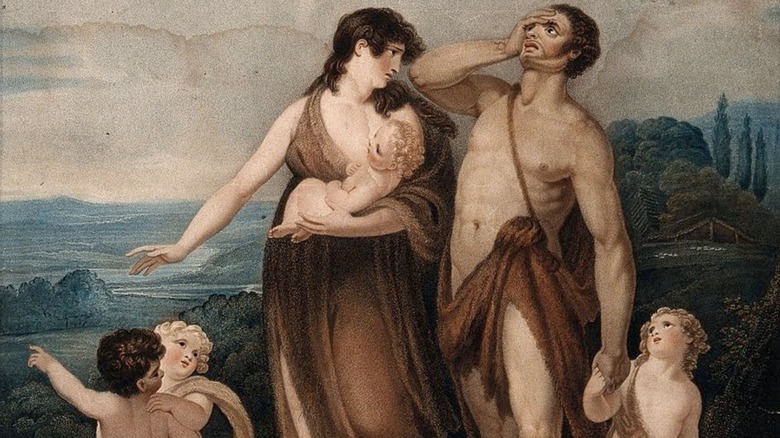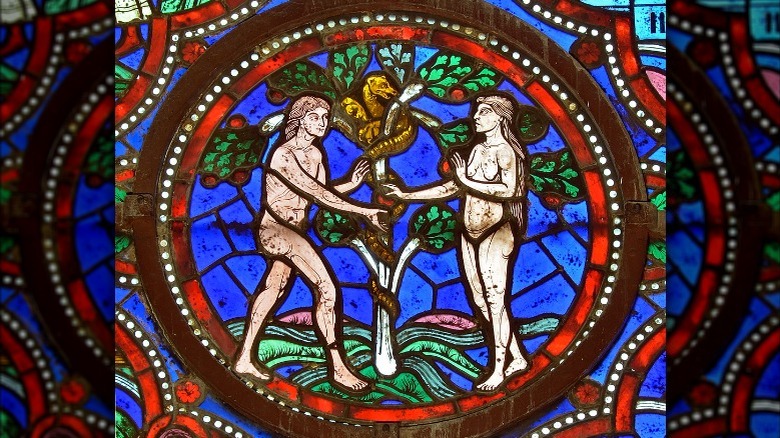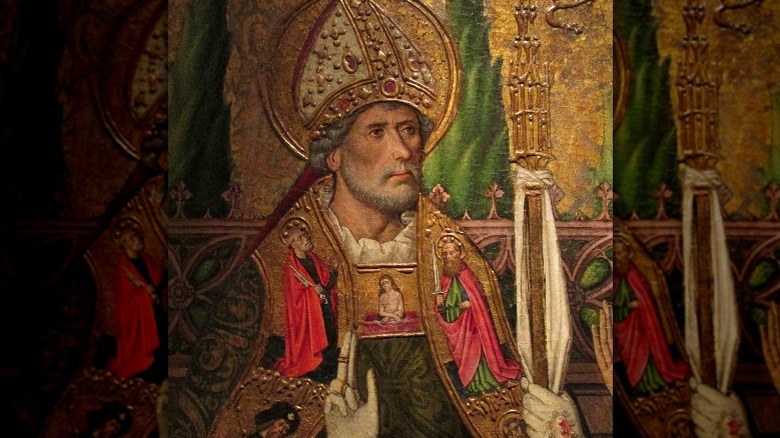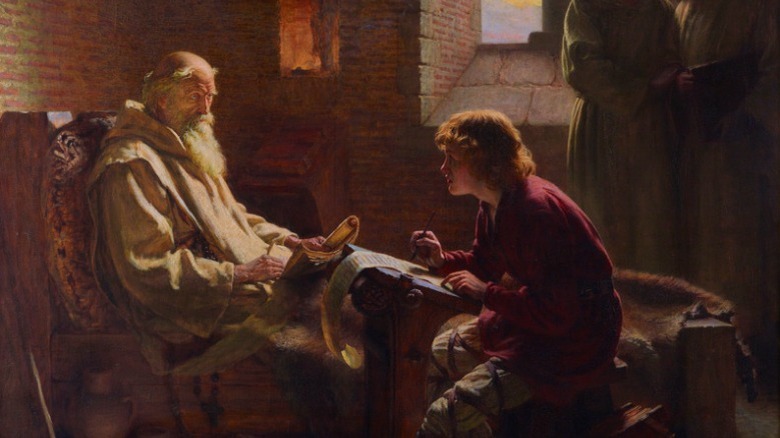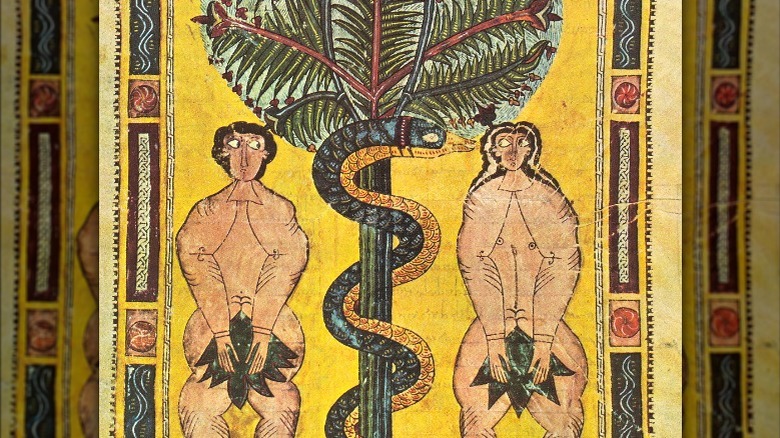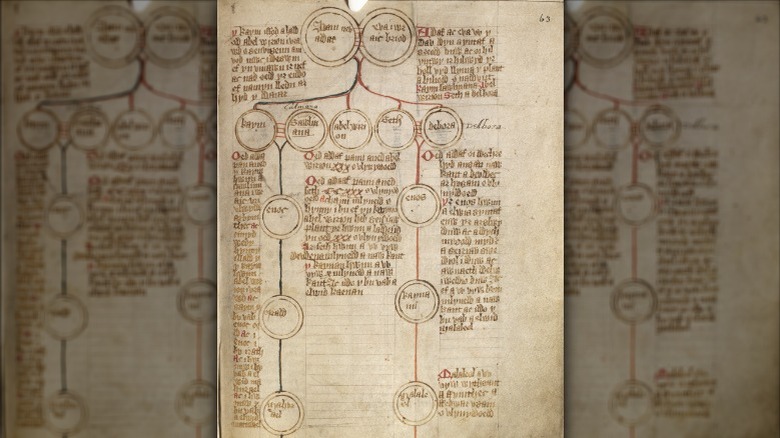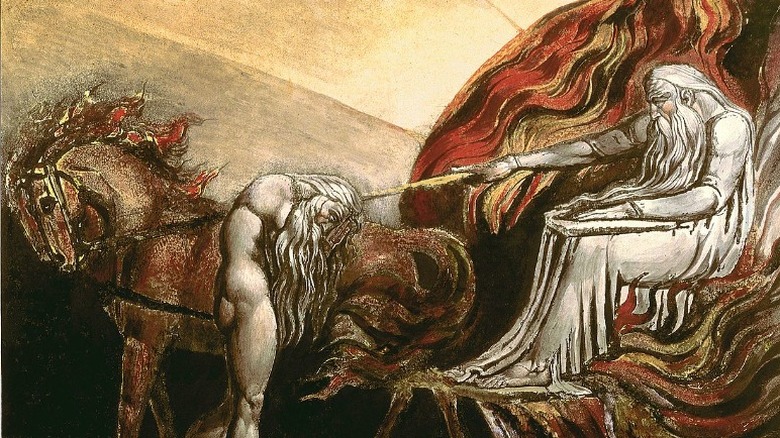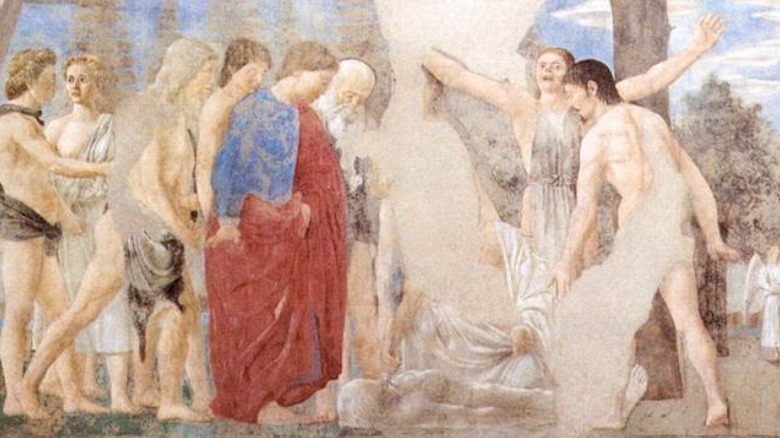The Untold Truth Of Adam And Eve
You don't need to attend church to know the basic story of Adam and Eve, as the Jewish and Christian creation story is ubiquitous. In the beginning, God has a creative frenzy, culminating in Adam. Adam gets lonely, so God makes him a partner, Eve, out of one of his ribs. Everything is great until a talking snake comes along and tells Eve to eat an apple, even though God specifically said not to. She does, then makes Adam do it. They realize they are naked and add some strategically placed leaves that will be very convenient to blushing artists throughout history who don't want to show genitals. God figures out what they did and they get in trouble. Thrown out of the Garden of Eden, they have to live in the crappy regular world, and we've all been punished for what they did since.
But is that the whole story of Adam and Eve? Is it even what the Bible actually says? Not even close.
The story of Adam and Eve was borrowed and changed
Like many stories in the Bible, Genesis has elements that were borrowed from other cultures and religions. When it comes to the bits about Adam and Eve, some key pieces are cribbed from the "Enuma Elis" and "Gilgamesh."
The Hebrews (they weren't Jews yet) were once in exile in Babylon, where they learned the "Enuma Elish" creation myth that involved a single, all-powerful god. But it was the myth of Gilgamesh that really influenced them. The hero Gilgamesh has a plant of immortality but loses it because of trickery by a snake. The gods also create a companion for the hero so he won't be lonely — although it was another man in that story — while a seductive woman ends up being responsible for men losing the idyllic lives they were living with animals and nature. After the fall in "Gilgamesh," the companion realizes he's naked and the text says he has become "like a God," just like Adam and Eve after they eat the forbidden fruit in Genesis.
But this doesn't mean the Hebrews' version can be dismissed as a rewrite. They wrote the stories present in Genesis after their exile was over, and by making their own mythology – a creation story of their very own — they were solidifying themselves as a people. Theologians are also fascinated by the changes they made to the parts they borrowed because it says a lot about what was important to them.
God creates humans twice in Genesis
If you thoroughly read Genesis, you'll notice God creates the universe and everything in it twice, and the two accounts directly contradict each other in some places, just one of the many parts of the Bible that don't make sense. If you don't take the creation story literally, as many Christians and Jews don't, then it's not an issue. However, the writing styles of the two stories are totally different, and they seem to have different theological goals they want to achieve by telling their version the way they do. This would heavily imply they were written by two different people at two different times for two different reasons and combined later. But that's a problem for some Biblical scholars, who believe Genesis was one story written completely by Moses.
Some people in history have gone to great lengths to make the two versions mesh, such as when they made Adam a hermaphrodite. In the first version of creation, it says God formed Adam and Eve at the same time, "male and female he created them." Some early Christian theologians decided this meant they had "serene undifferentiation" or where otherwise both sexes. Many church leaders were uncomfortable with that idea, but it stuck around as a theory for centuries.
The two versions of creation in Genesis are also where the idea of Lilith comes from. Jewish mythology says she was Adam's first wife, who then became a demon. Lilith is in the first creation story, while Eve is the latter one, where she is made from one of Adam's bones.
Was Eve made from Adam's baculum?
It's worth remembering that if you're reading the Bible in English, you're reading a translation, and this can lead to some interesting disputes. Just one of the things we get wrong about Adam and Eve centers around the detail of how Eve was created from one of Adam's ribs, because that's not what the original Hebrew word means. The word "tsela" appears 40 times in the Bible, and the only time it's translated as "rib" is when Eve shows up. It usually refers to the side of something or otherwise hanging of off the main trunk of an upright human. So if Eve was really just made from some vague side area of Adam, this leaves a lot of interpretation. Enter the dong bone theory.
One legitimate Biblical professor put forward the idea that Eve was actually made from Adam's baculum. Since the penis bone is extremely common in mammals (even other primates have one), but human males are missing this piece of kit, Dr. Ziony Zevit thinks Genesis holds the answer. As reported by Religious News Service, Zevit contends that If God took a bone from Adam, then his descendants presumably wouldn't have that bone. Men have an even number of ribs but are missing the baculum, so it stands to reason, Zevit says, that's the real bone God formed Eve from.
While scientists aren't actually sure why humans lost their baculum, people were understandably not exactly thrilled with this new theory. The Times of Israel reported that many readers were incensed at the idea, with one accusing Zevit of trying to "damage [her] faith" and cause her to doubt the Bible.
The belly button question
It seems like such a minor thing: Did Adam and Eve have belly buttons? But it's been a theological nightmare for millennia: If they had them, then they have the scar of a gestation that never occurred, so why would God put it there? On the other hand, if they didn't have belly buttons, then how were they perfect representations of humans?
Fundamentalist Christians tend to be "Team No Belly Button," with some asserting that there would be no reason for God to create Adam and Eve with one. A Congressional committee got involved in the debate in 1944, when it objected to a pamphlet given to soldiers that included an image of Adam and Eve with belly buttons, claiming that it was an insult to fundamentalists. The debate has also been a huge problem for artists through the centuries. Some just added a few convenient navel-covering leaves, and many left Adam and Eve with completely smooth stomachs. But after the Renaissance, most included belly buttons simply because they looked weird without them.
In a bizarre twist, the belly button debate once intersected with the early debate over evolution, when in 1857 Philip Henry Gosse said in his book "Omphalos" that Adam and Eve's belly buttons proved the Earth was only a few thousand years old. All the seemingly older stuff, like the fossil record, was just the Earth's version of an unused belly button.
Genesis says nothing about the forbidden fruit being an apple
Ask anyone what fruit Adam and Eve ate that made God angry and they'll tell you it was an apple. But if you actually read the Bible, it doesn't say anything at all about what specific kind of fruit it was. In English translations, it's just "the fruit" on "the tree." Even in the original language, the Hebrew word is "peri," which is equally as vague. Peri could mean almost any fruit, and Jewish scholars have ranged in choices from a fig, grape, citron, or even the distinctly non-fruity wheat. Others thought of it as an intoxicating drink, like wine.
So why is everyone so sure it's an apple? Because of a pun, that's why. In the fourth century A.D., Pope Damasus decided the Bible needed to be translated into Latin. The scholar Jerome was given the job, and when he got to the mention of the "Tree of the Knowledge of Good and Evil," he apparently decided to make a pun. In Latin, "malus" means evil, but it also means apple, so the fruit of the tree that let Adam and Eve know evil was an apple.
But it was John Milton who really cemented the image when he called the forbidden fruit an apple twice in "Paradise Lost." After that, pretty much all artists depicted Adam and Eve eating an apple, and today it's unusual to think of it as anything else.
Eve's sin meant women didn't get to use pain meds in childbirth for a long time
Evolution (or God, if you prefer) gave us big skulls and slim hips, so childbirth is extremely painful. Fortunately, we now have lovely drugs to take some of that agony away. But even before epidurals, there were plenty of ways to make birthing a baby less horrible for the mother. But men said no because Eve's sin of eating the forbidden fruit meant women had to suffer.
God does punish Eve in Genesis 3:16 (King James version) when he says, "... in sorrow thou shalt bring forth children." But here we have another translation issue. The original word for that sorrow means "labor, toil, or work" everywhere else in the Bible. Only when talking about giving birth did translators decide it also included pain. Women in labor probably don't care about the deep theological implications — they just want the pain to stop — but religious men through the centuries sure have.
According to the Journal of Anesthesia History, Martin Luther once wrote that women should be thrilled that they got to "gloriously suffer" to bring forth babies, and a (male) New England pastor once opined that alleviating the pain of women in childbirth would "deprive God of the pleasure of their deep, earnest cries of help." This theological argument resulted in a huge backlash when pain medication started being used during labor in the 1800s. Since God allegedly demanded that there be pain, taking it away was sacrilegious. Even today, some people still feel this way.
Islam has a slightly different Adam and Eve story
Adam and Eve don't just show up in the Jewish and Christian holy books; they make an appearance in the Quran as well. But the Islamic version of their story has some key differences from the other Abrahamic religions.
It starts out similarly: God makes Adam and Eve, who are special compared to the animals, and tells them they can't eat from the special tree. Then Satan comes along and tricks them into eating from the tree. But here is a major theological change: Satan tricks them both, not just Eve. They both eat from the tree and they are both equally to blame. Nowhere in the Quran is Eve a temptress, nor does God give women the punishment he does in Genesis because of what she did. There is no concept of original sin in Islam, either. Adam and Eve were punished for what they did, but that punishment was for them alone, not all of humanity forever.
Later Islamic traditions added to the story. They say when Adam and Eve were thrown out of the Garden of Eden, they were separated for 200 years. When they meet up again, they have two sons called Qābīl and Hābīl, who each had a twin sister. And just like Cain and Abel, Qābīl kills Hābīl. But there were plenty of other kids to make up for that loss, as Eve eventually had 20 sets of twins and before he died, Adam had 40,000 offspring.
The pre-Adamite movement explains evolution and supported slavery
In the 1800s, scholars started to understand more about the ancient Egyptian civilization. Texts were being deciphered and monuments dated, and it also happened that a lot of the stuff being turned up was really old. This presented a conundrum for Christianity; if the Bible is literal and Adam and Eve were only created a few thousand years ago, how could the Egyptian artifacts be older than that? According to some, the pre-Adamite theory held the answer.
Pre-Adamite simply means that there were people alive before Adam. This idea dates back to 1655, when the French theologian Isaac La Peyrère wrote two books about it. This theory solved some other problems, such as where Cain's wife came from. In Genesis, only Adam, Eve, Cain, and Abel have been mentioned by the time Cain murders his brother. But suddenly we learn there are cities of people and Cain quickly finds a wife. The pre-Adamite theory explains where they came from.
Some Christians also liked this idea because it meant some people on Earth were descended from others than Adam and Eve, and were therefore not as important. Shocking no one, those inferior people were theorized to be the less white ones, and the idea was used to justify enslavement. These days some evangelicals still embrace the theory to explain the evidence for evolution and ancient archeological finds, saying that early humans lived for millions of years, went extinct, and then God replaced them with Adam and Eve, who were special.
The Garden of Eden has been located everywhere
Throughout history, many have believed that the Garden of Eden was a real place, and some of them set out to find it. This was a difficult task, since Genesis says it was located where one river splits into four, and that's it. Not a lot to go on.
Christopher Columbus was one particularly famous seeker of Adam and Eve's first home, and he thought he was close when he landed on Hispaniola, and even closer in Venezuela. The explorer David Livingstone declared it was at the source of the Nile, although he was mad with malaria at the time. Methodist minister William Warren wrote a book in 1881 explaining how he figured out Eden was located at the North Pole. But almost simultaneously, other people were publishing their proof that the earthly paradise was outside Damascus or in California's Santa Clara Valley. Later on, the 20th century saw claims of "proof" it was in Ohio, Florida, and Mongolia, while some residents of Seychelles were hoping to rediscover Eden, alleged to be on one of their islands, before Queen Elizabeth II visited in 1972. Other theories include Azerbaijan, Armenia, Bahrain, South Carolina, Somalia, or submerged in the Persian Gulf.
But the most commonly accepted location over the years has been Iraq. Not that it's that simple: If you go to Iraq wanting to visit paradise, there are two competing places that both claim to be the real Garden of Eden.
The number of Christians who think the creation story is literal is dropping
There is often an assumption that Christians believe the creation story in Genesis is absolutely literal and that Adam and Eve actually existed. There definitely are people who believe that, but in America, at least, they're dwindling. According to a Gallup poll in 2024, only 37% of adult American Christians surveyed believed God created Adam and Eve as fully human individuals about 10,000 years ago, while 34% believed evolution happened but with God's guidance in some way, and both of these responses have been on a downward trajectory since the end of the 20th century. However, 24% of the group surveyed believed in a God-free evolution process, a number that has more than doubled since 1999, and includes both Protestants and Catholics.
Even evangelicals are starting to break from a strict interpretation. Some Christian scholars have been reported as wanting their faith to catch up with accepted science, and that doing so does not automatically exclude religious beliefs. As Trinity Western University's biology professor, Dennis Venema, told NPR, "It's actually an opportunity to have an increasingly accurate understanding of the world — and from a Christian perspective, that's an increasingly accurate understanding of how God brought us into existence."
In this, they are just following what the original writers of Genesis might have had in mind, as Christian scholars have long believed it was originally written as allegory and poetry more than history. It wasn't until St. Augustine started thinking deep theological thoughts about creation in the fourth century A.D. that anyone said it should be taken literally.
Who were genetic Adam and Eve?
In 2018, tabloids and other less reputable news sources reported on a study published in the journal Human Evolution. But they got it completely wrong. If you believed the headlines, scientists had proven the existence of Adam and Eve. They traced our genetics back and discovered we all come from one couple who lived tens of thousands of years ago. Of course, that's not actually how it works.
The study only looked at mitochondrial and Y-chromosome DNA. That leaves a whole lot more chromosomal DNA that could (and almost certainly did) come from other people. Nor were "Mitochondrial Eve" and "Y-chromosomal Adam" a couple. Not in the slightest. Scientists narrowed the time Mitochondrial Eve was on Earth to 100,000-230,000 years ago. Even with such a vast time period for him to overlap, Y-chromosomal Adam probably lived about 75,000 years before her.
Nor were scientists saying these two people were the first people on Earth. Despite her misleading nickname, Mitochondrial Eve was supposed to represent "the most recent common mitochondrial ancestor of all living humans ... not the first human woman ever," according to Roger Bull of the Canadian Museum of Nature (via Smithsonian). But so many news stories got it wrong that the researchers had to release a statement saying they believed in evolution and were not saying there was a single Adam and Eve.
Adam and Eve had a lot of kids
For almost 400 years after Jesus' ministry, early Christians didn't have a set book of theology. Anyone who wanted to could come up with their own stories or write their own version of history to help explain and form this new religion. One of the subjects that interested these early Christian authors was the children of Adam and Eve. Various books, now not considered official Christian theology by most mainstream denominations, discussed the daughters of Adam and Eve, giving two of them names and full lives.
But when it comes to the now-official Bible and the Torah, you might think it's canon that Adam and Eve only had three children: Cain, Abel, and Seth. In fact, even Genesis mentions many more children for the pair, although it gives no other details. But Genesis 5:4 is very clear, "... the days of Adam after he had begotten Seth were eight hundred years: and he begat sons and daughters." The pluralization of those words indicates that there would have been at least two more children of each sex, bringing the minimum number of kids they had to seven. But as Adam lived to be 800 years old, it's not much of a stretch for Biblical scholars to assume there were plenty more.
Eve and the snake
It can be argued that a certain short passage in Genesis, where a talking snake convinces Eve to eat from a special tree in the middle of the Garden of Eden, is one of the most impactful stories in human history. It has been used for any number of theological, social, and political purposes throughout the millennia. But the story is a lot more complicated than a Sunday school version might have imparted to most people.
First, while Genesis is clear that the animal involved is a snake, it never says anything about the snake being the devil. This detail was apparently added later by other Jewish and Christian writers, and seems like a logical inference until you think about the story a bit deeper. God had just created the animals, after all, so did he create the snake as Satan? If so, what does that mean for this story? Some argue that the snake isn't even a very important part of the morality tale at all and doesn't deserve all the attention later retellings give to it.
It's also significant that Eve never actually heard the commandment from God not to eat from the tree, she only got a paraphrased version from Adam. So, when the snake appears and skillfully uses conversational and rhetorical tricks, Eve is convinced it is a good idea to disobey God.
Christianity didn't blame Adam and Eve for 'original sin' for hundreds of years
Many Christian denominations believe in the concept of "original sin," which is the idea that all humans are born already in a sinful state. How can a baby fresh from the womb already have sinned? Because Adam and Eve passed on their terrible sin of disobedience in the Garden of Eden to every single person who came after them. Or so the theory goes.
Despite original sin being such a big part of Christian theology, it wasn't actually a thing for the first 400 or so years after Jesus. In fact, many early Christian theologians, including the incredibly influential bishop St. Irenaeus of Smyrna, argued that if humans ever had original sin, Jesus removed it for everyone when he was crucified. One of the early discussions among church fathers was about the act of infant baptism. Jesus was baptized as an adult, so why would it be important for present-day Christians to be baptized as babies instead? Many theologians tied this back to original sin, presenting deep philosophical explanations on how Adam's soul could have passed on this original sin, while arguing over the three possible ways they considered it could have happened.
Finally, St. Augustine of Hippo (pictured) wrote the defining works on the question of original sin around A.D. 400. Working on the incorrect assumption Christians had always agreed infant baptism was required, he retconned original sin to give a reason for this sacrament. From then on, it was a Christian fact.
The 'four wounds' of Adam and Eve's fall
Even after Christians settled on the concept of original sin, they were not done discussing just how much Adam and Even had screwed humanity by eating that one piece of fruit. Christian theologians have argued that the idea of four "wounds" that resulted from Adam and Eve's fall from grace in the Garden of Eden started with the Venerable Bede (pictured), who was writing around A.D. 700. But it was Thomas Aquinas who really ran with them in his seminal "Summa Theologica."
As Aquinas put it, "In so far as reason has lost the way to truth, there is the wound of ignorance. In so far as the will has lost its inclination to good, there is the wound of malice. In so far as the irascible power has lost its aggressiveness towards the difficult, there is the wound of weakness. Finally, in so far as desire is no longer directed to the delectable under the restraint of reason, there is the wound of desire." In other words, every important thing that makes us human was deeply wounded by that one healthy snack.
All Saints Anglican Church explains what this means for Christians who follow this theology, stating that the wounds caused "a destructive disharmony in our soul," meaning you will fail and eventually die. Various Christian denominations have different ways of fixing this problem, including good works and baptism. (Since they still physically die, of course, the idea is your soul will not.)
The Adam and Eve story is full of puns
The story of Adam and Eve is absolutely stuffed with what are, effectively, dad jokes. Take a look at this one from Genesis 2:5: "... there was not a man to till the ground." Groan, right? And then the author really brings the punchline home with a callback to the joke in Genesis 3:19, when God tells Adam he's going to be punished for his disobedience: "... in the sweat of thy face shalt thou eat bread, till thou return unto the ground; for out of it wast thou taken." Hilarious, right?
If you're confused, don't worry. Since Genesis was originally written in Hebrew, the jokes don't work in English (or most other languages). And it seems translators over the centuries didn't think it was important to keep the puns. But in Hebrew, those puns have real meanings that help interpret the text.
A close English equivalent would be if Adam's name was translated as "Earthling." So when the text mentions Adam and the earth together, it would be saying something along the lines of "one day you're going back to the earth, but until then you are going to farm the earth, Earthling." This gives those lines deeper meaning even today, and in a sustenance society like the Hebrews faced in their arid region, this would have been a very overt reference to how difficult and finite life is.
Many people tried to nail down exact dates for Adam and Eve
A 2024 Gallup poll found that 37% of adults in the U.S. believed in the Biblical story of Creation. (On the other hand, a total of 58% believed in human evolution, either with God's help or without.) Those creationists appear to take the Adam and Eve story literally, and believe they were real people who existed, at most, 10,000 years ago. But where does that date come from? And is that really as specific as the timeframe gets?
The Bible, particularly the Old Testament, loves a genealogy (the infamous "so-and-so begat so-and-so, who begat so-and-so" parts). Based on the two lists of who begat whom in Genesis, which cover the generations between Adam and Abraham, plus the many other begat lists that ultimately culminate with Jesus, historical theologians settled on about 4,000 BC as the date of the creation of the earth. However, for various reasons, others believe the genealogies are missing some names, and that the date could be as much as 10,000 to 12,000 years ago.
But theologians have gotten even more specific. Around A.D. 700, the Venerable Bede wrote that the creation took place in the spring. In 1642, the scholar John Lightfoot famously determined that "man was created by the Trinity on October 23, 4004 BC at nine o'clock in the morning" (via the University of Virginia). And in 1650, Archbishop James Ussher calculated that Adam and Eve were thrown out of the Garden of Eden on Monday, November 19.
How did Adam live for so long?
The men featured in Genesis must have been doing plenty of exercise and getting their fiber, because they lived a long, long time. Genesis 5 lists a bunch of their ages when they died, and it says Adam made it to 930 years old, while his son Seth was 912 before he kicked the bucket.
For those people who believe the stories in Genesis are literal, this presents an interesting conundrum. How could Adam and his progeny live almost 1,000 years when so few people these days even make it a tenth as long? Some have proposed that the vitality of creation, combined with the Garden of Eden's high-quality food and even the fruit of the tree of life, as well as a pious life, promoted an exceptional life span. Others have taken a more scientific stance, blaming our shorter modern lifespans on a genetic deterioration that has been ongoing since Adam. And then there's a hint in the biblical narration just prior to the great flood, wherein Genesis 6:3 states: "And the Lord said, My spirit shall not always strive with man, for that he also is flesh: yet his days shall be an hundred and twenty years." In other words, humans were supposed to live a long time, but once we became so wicked that God had to send a flood, he reduced our lifespans as punishment. God then reduced lifespans further and further until settling on 70 years, as Psalm 90 states, "The days of our years are threescore years and ten."
However, many Christians believe that Adam's lifespan was not meant to be literal but symbolic, and once represented something important in ancient Hebrew numerology.
Adam was the first natural death, while Eve's death invented the funeral
According to Genesis, the first death that ever occurred on Earth was when Cain murdered his brother Abel. But it would be many hundreds of years, when Adam died at the ripe old age of 930, before the world saw its first death from natural causes. Genesis is light on the details around this momentous event, which means other Jewish writers, as well as some early Christian ones, stepped in to fill in the gaps. One such book of unknown provenance that covers this topic is the "Life of Adam and Eve," also known as the "Apocalypse of Moses," which was written in antiquity.
In this story, Adam is old and not feeling great. He says God has struck him with 72 different ailments over his lifetime, including eye pain and hearing loss. But now Adam knows he's dying, and while Eve and Seth try to save him with oil from the Garden of Eden, it's no use. An angel tells them Adam had just three days to live. The couple ate from the tree of knowledge of good and evil, so now humans all have to die. But Adam makes sure Eve knows it's all her fault before he gives up the ghost: "And Adam saith to Eve: 'Eve, what hast thou wrought in us? Thou hast brought upon us great wrath which is death...'"
After Adam dies, Eve asks God to die too, and he obliges. Then the archangel Michael "came and taught Seth how to prepare Eve for burial ... and saith: 'Lay out in this wise every man that dieth till the day of the Resurrection.'"
Adam and Eve are said to be buried in the Cave of the Patriarchs
You would think it would be near impossible to know where the first two people on Earth were buried, even if they did live less than 10,000 years ago, as creationists estimate. But tradition is clear on exactly where they are buried, and it's the second holiest location in Judaism, after the Temple Mount. Called the Cave of Machpelah or the Cave of the Patriarchs, it's located in Hebron, a city in the occupied West Bank.
As the Kabbalah text the Zohar explains, after the fall of man, Adam realized there was a gateway to the Garden of Eden in the ground when he saw light coming from it. He picked that spot as his and Eve's final resting place, digging a cave for their gravesite. Eventually, Adam's decedent Abraham accidentally found the cave, so he picked it as his burial site, too, as did the other Old Testament headliners Sarah, Isaac, Rebecca, Jacob, and Leah. That adds up to four major Jewish power couples buried in one place, one that also led to the Garden of Eden. So you can see why it's special.
The large building that surrounds the graves was built in the 1st century BC by King Herod of baby-killing fame. The location has been under Muslim jurisdiction for about 700 years, and non-Muslims have generally not been allowed into the cave since then, although a few Jews and Christians have managed to sneak in.

